In the fiercely competitive e-commerce landscape, your pricing strategy can make or break your Shopify store. Discounts aren’t just sales tactics—they’re powerful psychological triggers that can transform browsers into buyers and first-time customers into loyal fans. The numbers don’t lie: 49% of households cite price as the #1 factor influencing their spending decisions. More telling, 93% of shoppers make repeat purchases with retailers offering attractive discounts, and 80% of consumers feel encouraged to make first-time purchases after finding compelling discounts.
But here’s what many store owners miss: discounts deliver benefits far beyond immediate sales bumps. They help you stand out in crowded marketplaces, clear seasonal inventory without painful write-offs, acquire customers at lower costs, and build the kind of loyalty that keeps shoppers coming back month after month.
So how do you harness this power without slashing your profits? That’s exactly what we’re diving into today.
The Impact of Pricing on Consumer Behavior
Price cuts trigger something primal in consumers. They create a sense of urgency, reduce purchase hesitation, and generate that little dopamine hit that makes shopping feel rewarding. But not all discounts are created equal, and different discount types trigger different customer responses.
When a shopper sees 50% off, their brain processes that differently than “$50 off” or “Buy one, get one free.” Understanding these psychological nuances is your first step toward crafting discount strategies that genuinely drive results instead of just cutting into your margins.
Shopify’s Discount Capabilities Overview
Shopify comes packed with robust discount functionality right out of the box. The platform offers two primary discount delivery methods: discount codes (which customers enter at checkout) and automatic discounts (which apply without any customer action required).
These tools integrate seamlessly with Shopify POS, allowing you to create consistent omnichannel promotions that work both online and in physical stores. While the native features handle most common discount scenarios, it’s essential to understand both their power and their limitations.
One of Shopify’s strengths is its ability to target discounts to specific customer segments. This means you can craft different promotions for first-time buyers, loyal customers, cart abandoners, or specific geographical regions—a level of precision that transforms discounting from a blunt instrument into a surgical tool.
Now that we understand why discounts matter, let’s explore the different types available in Shopify and when to deploy each for maximum impact.
Comprehensive Overview of Shopify Discount Types
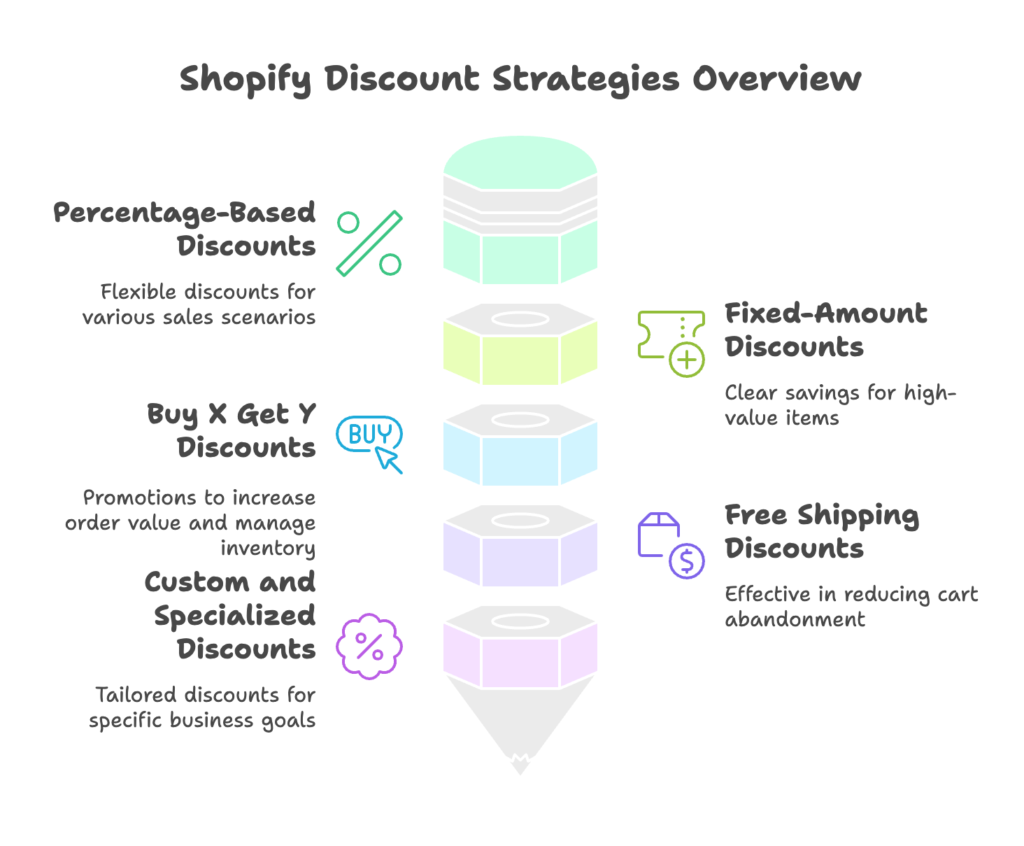
Percentage-Based Discounts
Percentage discounts are the workhorses of e-commerce promotions. They’re intuitive for customers to understand—”20% off” immediately communicates value without requiring mental math. These discounts can be applied store-wide, to specific collections, or to individual products, giving you tremendous flexibility.
Store-wide percentage discounts work beautifully for major sales events like Black Friday or your store anniversary. Collection-specific discounts help you move seasonal items or promote specific categories. Individual product discounts can spotlight new arrivals or help clear slow-moving inventory.
Setting up percentage discounts in Shopify is straightforward. Navigate to Discounts in your admin panel, click “Create discount,” select “Percentage” as your discount type, and specify the discount value and eligible products. You can also set usage limits, active dates, and customer eligibility to fine-tune your promotion.
But when should you reach for percentage discounts? They’re particularly powerful for:
- Seasonal sales where customers expect significant savings
- Loyalty rewards where the percentage off feels like recognition of customer value
- New category launches where you want to encourage exploration without dramatically cutting prices
Pro tip: For lower-priced items (generally under $100), percentage discounts tend to feel more valuable to customers than fixed amounts. This brings us to our next discount type.
Fixed-Amount Discounts
Fixed-amount discounts specify an exact dollar value to be subtracted from an order or product. Examples include “$20 off your purchase” or “$10 off Product X.” These discounts can be particularly effective for higher-priced items where a percentage might not feel as substantial.
The key advantage of fixed-amount discounts is clarity—customers know exactly how much they’re saving without doing any calculations. This can be especially powerful when you’re trying to hit specific price points, like bringing a $109 item down to $99 or getting an order just under the free shipping threshold.
When implementing fixed-amount discounts, you can apply them at the order level (“$25 off orders over $100”), to specific products, or create tiered discounts based on spending thresholds (“$10 off $50, $25 off $100, $50 off $200”).
This brings us to an important principle in discount psychology: the Rule of 100. Research shows that for products priced under $100, percentage discounts feel more valuable to customers (25% off a $40 item is more appealing than $10 off). For products over $100, fixed-amount discounts tend to feel more substantial ($50 off a $250 item sounds better than 20% off).
Fixed-amount discounts shine in these scenarios:
- High-value product promotions where the dollar amount saved makes a statement
- Minimum purchase incentives that encourage customers to add more to their carts
- Gift card-like promotions that feel like free money rather than a reduction
When setting up these discounts, be strategic about your thresholds. Analyze your average order value and set minimum requirements just slightly above it—this encourages customers to add just one more item to qualify.
Buy X Get Y Discounts (BOGO)
BOGO (Buy One, Get One) promotions are among the most versatile and psychologically powerful discount types. They create a perception of getting something for free rather than simply paying less, which taps into our innate love of “free” items.
Shopify allows several BOGO variations:
- Buy one, get one free (classic BOGO)
- Buy one, get one at X% off (like 50% off the second item)
- Buy X quantity, get Y quantity free (buy 3, get 1 free)
- Buy from collection X, get a discount on collection Y (cross-category promotion)
BOGO discounts excel at increasing average order value since customers must purchase multiple items to receive the benefit. They’re also exceptionally good at inventory management—if you have excess stock in certain categories, BOGOs can help move those products without explicitly marking them as “clearance” (which can damage perceived value).
Setting up BOGO discounts in Shopify requires a bit more configuration than simple percentage or fixed-amount discounts. You’ll need to specify both the qualifying products and the products eligible for the discount. Pay special attention to your visual merchandising when running BOGO promotions—make it easy for customers to find complementary items.
BOGO promotions work particularly well for:
- Inventory balancing when you have overstock in specific categories
- Cross-selling related products (buy a phone, get 50% off a case)
- Introducing new product lines by bundling them with established sellers
- Encouraging bulk purchases of consumable products
Remember that while “buy one, get one free” sounds like a 50% discount, it often delivers more value to you as a merchant because it moves twice the inventory and typically has higher perceived value to customers than a straight 50% off promotion.
Free Shipping Discounts
Never underestimate the power of free shipping. Studies consistently show that shipping costs are the #1 reason for cart abandonment, and free shipping offers generate approximately 2x higher response rates compared to percentage-based price discounts of equivalent value.
Why? Because shipping fees feel like a penalty or tax rather than part of the product cost. Removing this friction point creates a psychologically smoother path to purchase.
Shopify offers several ways to implement free shipping discounts:
- Unconditional free shipping for all orders (simple but potentially costly)
- Threshold-based free shipping (“Free shipping on orders over $50”)
- Product-specific free shipping for high-margin or promotional items
Threshold-based free shipping is particularly powerful for increasing average order value. When customers see they’re just $10 away from free shipping, they’ll often add additional items to their cart rather than pay for shipping—even if the extra items cost more than the shipping fee would have been!
A key advantage of free shipping discounts is their perception as added value rather than discounted value. This subtle distinction helps maintain your product’s perceived worth while still offering a compelling incentive to purchase.
When implementing free shipping offers, consider these regional factors:
- Shipping costs vary dramatically by location, so you may need region-specific thresholds
- International shipping poses unique challenges—you might offer free domestic shipping while maintaining reasonable international rates
- Customer expectations around shipping speed can impact the perceived value of your free shipping offer
For many stores, a permanent free shipping threshold slightly above your average order value combined with occasional unconditional free shipping promotions provides the optimal balance of margin protection and conversion boosting.
Custom and Specialized Discounts
Beyond the core discount types, Shopify supports several specialized discount structures that can address specific business objectives. These often require additional configuration or apps but can deliver powerful results for the right products and customer segments.
Volume Discounts offer tiered pricing based on purchase quantity (buy 1-5 at $20 each, 6-10 at $18 each, 11+ at $15 each). These incentivize bulk purchases while maintaining margins on smaller orders. They’re particularly effective for consumable products, wholesale segments, or items frequently purchased in multiple quantities.
Bundle Discounts encourage customers to purchase complementary items together at a reduced price compared to buying them separately. Think of camera bundles with lenses and accessories, or “complete the look” fashion promotions. This strategy increases average order value while introducing customers to more of your product range.
Mix & Match Deals allow customers to build their own bundles from select product groups with a discount applied when purchasing multiple items. This approach works well for apparel (“Any 3 shirts for $50”), beauty products, or food items where customers appreciate choice flexibility.
Implementing these specialized discounts often requires careful planning and possibly third-party apps to extend Shopify’s native functionality. The additional complexity is justified when these promotions align closely with your specific inventory, margin structure, and customer preferences.
Now that we’ve explored the various discount types available in Shopify, let’s look at the different ways to deliver these discounts to your customers.
Discount Delivery Methods in Shopify
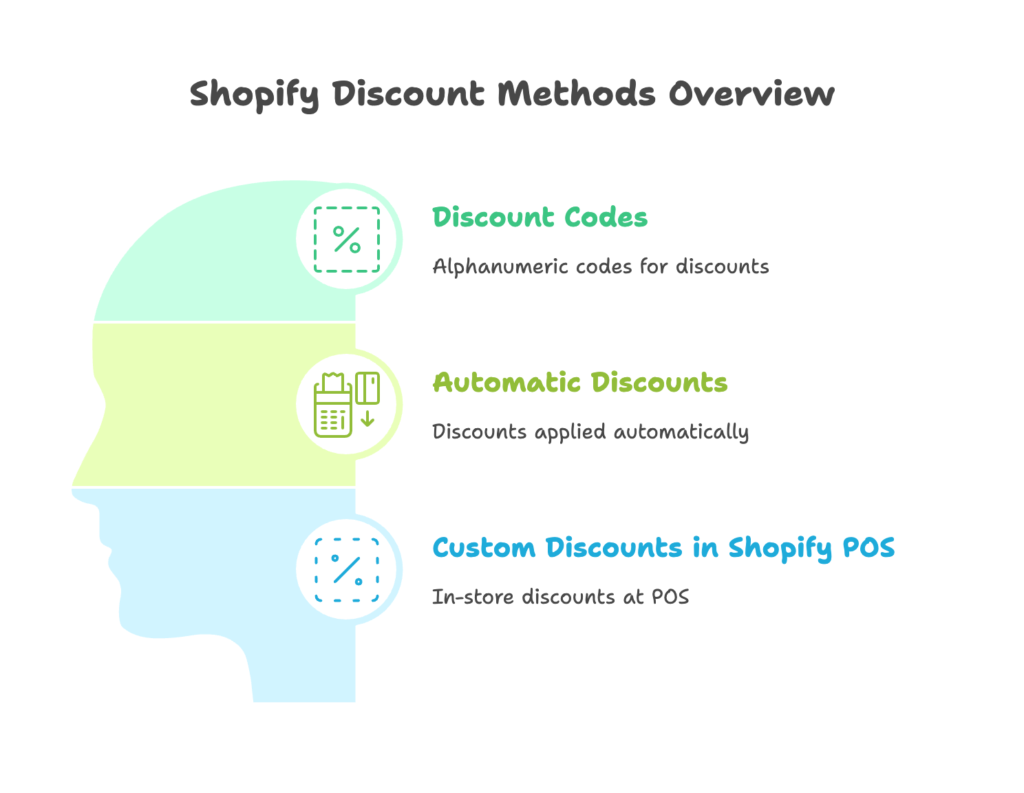
Discount Codes
Discount codes (sometimes called coupon codes or promo codes) are alphanumeric codes that customers enter at checkout to receive a discount. They’re incredibly versatile and offer several unique advantages in your promotional arsenal.
Shopify supports multiple types of discount codes:
- Single-use codes that can only be redeemed once
- Multiple-use codes with optional usage limits
- Customer-specific codes that only work for targeted individuals
What makes discount codes particularly powerful is their trackability. Each code can be associated with a specific marketing channel, campaign, or initiative, allowing you to precisely measure which promotions drive the most revenue. This makes them ideal for influencer collaborations, affiliate programs, email campaigns, or social media promotions.
When generating discount codes, follow these best practices:
- Use a consistent naming convention that indicates the promotion type, channel, and date
- Create memorable codes for public promotions (SUMMER25 is better than X7YTP9)
- Set appropriate usage limits and expiration dates to create urgency
- Regularly audit and deactivate expired codes to maintain system cleanliness
While discount codes offer excellent flexibility and tracking, they do require customer action—entering the code at checkout. This extra step creates some friction in the purchase process, which brings us to our next delivery method.
Automatic Discounts
Automatic discounts apply without requiring customers to enter a code. They’re applied based on what’s in the cart, who the customer is, or other conditions you specify. The primary advantage is reducing friction in the checkout process—no codes to remember or enter means fewer opportunities for checkout abandonment.
Shopify allows several types of automatic discounts:
- Threshold-based discounts that activate when an order reaches a specified value
- Product-specific discounts that apply to particular items or collections
- Customer segment discounts based on shopping history, location, or tags
Automatic discounts are particularly effective for:
- Preventing cart abandonment by surfacing savings immediately
- Creating a seamless shopping experience with less friction
- Supporting loyalty programs with automatic tier-based benefits
When implementing automatic discounts, transparency is key. Make sure customers clearly see the savings they’re receiving—whether through crossed-out original prices, explicit “You saved $X” messaging, or notification banners—to maximize the psychological impact of your promotion.
One limitation to note: Shopify restricts how automatic discounts can combine with other promotions. Generally, only one automatic discount can apply to a given product, though this can be supplemented with discount codes. Carefully test your promotion combinations to ensure they behave as expected.
Custom Discounts in Shopify POS
For merchants with physical stores using Shopify POS, custom discounting at the point of sale adds another layer to your discount strategy. These in-the-moment discounts can help close sales, match competitor pricing, or accommodate special circumstances like minor product defects.
Shopify POS supports both line-item discounts (applied to specific products) and cart discounts (applied to the entire purchase). Staff can apply these as either percentage or fixed amounts, depending on the situation.
When implementing POS discounts, consider these factors:
- Staff permissions—who can apply discounts and of what magnitude
- Tracking and accountability for manual discounts
- Consistency between online and in-store promotion strategies
- Staff training on appropriate discount usage and communication
A cohesive omnichannel discount strategy ensures that customers have consistent experiences whether shopping online or in-store. Shopify’s reporting tools can help you track discount usage across channels, identifying patterns and optimization opportunities.
With an understanding of discount types and delivery methods, let’s explore when and how to strategically deploy these tools for maximum impact.
Strategic Timing and Targeting of Shopify Discounts
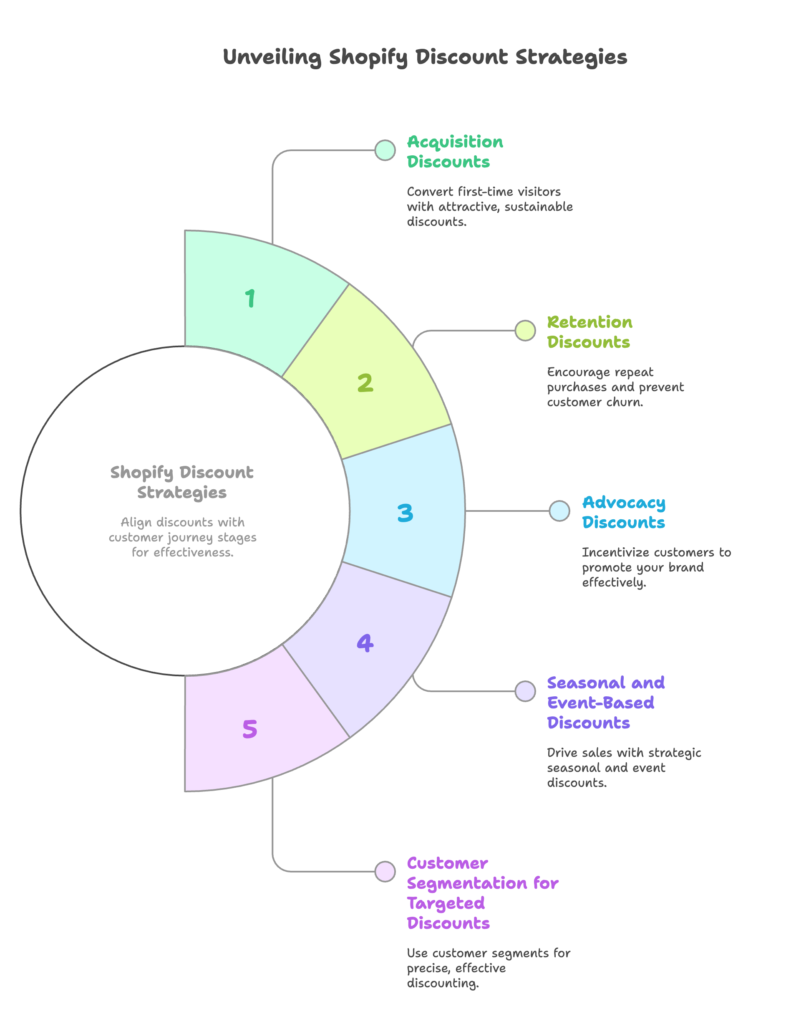
Customer Journey-Based Discount Strategies
The most effective discount strategies align with specific stages of the customer journey. Different discounts serve different purposes depending on whether you’re trying to acquire new customers, retain existing ones, or turn satisfied customers into active advocates.
Acquisition Discounts aim to convert first-time visitors into customers by reducing the risk of trying your store. Effective acquisition offers include:
- First-purchase discounts (10-15% off your first order)
- Email signup incentives (Get $10 off when you join our list)
- Referral discounts (Your friend gets $10, you get $10)
The key to successful acquisition discounts is balancing attractiveness with sustainability. A 50% off first purchase might drive signups, but if you lose money on every new customer, growth will hurt rather than help your business. Aim for discounts that still allow for some profit or at least break-even, considering customer lifetime value.
Retention Discounts focus on encouraging repeat purchases and preventing customer churn. These include:
- Post-purchase follow-ups (Thanks for your order! Here’s 15% off your next purchase)
- Win-back campaigns for lapsed customers (We miss you! Come back for 20% off)
- Loyalty program tier benefits (Silver members get free shipping, Gold members get 5% off every order)
Retention discounts should generally become more valuable as customer loyalty increases. This rewards your best customers while encouraging casual shoppers to increase their engagement to reach higher benefit tiers.
Advocacy Discounts incentivize customers to spread the word about your brand. These include:
- Referral rewards (Get $15 for each friend who makes a purchase)
- Social sharing incentives (Share your purchase for 10% off your next order)
- Review and testimonial rewards (Leave a review to receive a special discount)
Advocacy programs effectively turn your satisfied customers into a marketing channel, often delivering higher-quality leads at lower costs than traditional advertising. The key is making both the action and the reward simple and worthwhile.
Seasonal and Event-Based Discount Planning
Strategic discount planning around seasonal events can drive predictable sales spikes and inventory turnover. While the specific seasons relevant to your business will vary by industry, most e-commerce stores benefit from planning around these key periods:
Holiday Season Strategy requires careful planning well in advance. Black Friday and Cyber Monday represent the highest-volume shopping days for many merchants, while Christmas, Hanukkah, and other December holidays drive gift-focused purchases.
Effective holiday discounting often involves a progression of offers:
- Early access sales for email subscribers or loyal customers
- Doorbuster or limited-time offers to create urgency
- Gift-focused bundles that simplify shopping decisions
- Post-holiday clearance to move remaining seasonal inventory
Industry-Specific Seasonal Opportunities vary by niche but often present significant sales opportunities:
- Fashion: Spring/Summer and Fall/Winter collection transitions
- Education: Back-to-school season in late summer
- Fitness: New Year’s resolution period in January
- Home goods: Spring cleaning season and moving season (summer)
Identify the natural seasonal cycles in your industry and plan discount strategies that align with customers’ needs during these periods.
Business Milestone Promotions celebrate your store’s achievements while driving sales:
- Store anniversary sales
- Customer milestones (10,000th customer, 100,000th order)
- New product launch or category expansion events
These celebrations create authentic reasons for promotions while strengthening your brand story and customer connection.
Customer Segmentation for Targeted Discounts
Not all customers should receive the same discounts. Targeted offers based on customer segments often deliver better results at lower discount costs. Shopify provides several ways to segment customers for precision discounting:
Behavioral Segmentation targets customers based on their actions (or inactions):
- Cart abandonment recovery (Forgot something? Here’s 10% off to complete your purchase)
- Browse abandonment (Still interested in that dress? It’s now 15% off)
- Purchase frequency segments (Our top customers get exclusive access to this sale)
Behavioral triggers often catch customers when they’re already interested, making them particularly effective at lower discount levels.
Demographic Segmentation personalizes offers based on customer attributes:
- Age-specific promotions (Student discount, Senior discount)
- Location-based offers (Free shipping to California this week only)
- Interest-based discounts (Special offer for our yoga enthusiasts)
These segments help make promotions feel more relevant and personal, increasing their effectiveness.
Value-Based Segmentation aligns discount investments with customer value:
- VIP customer exclusive offers for your top 10% of spenders
- High average order value incentives that reward big spenders
- Lifetime value-based tiering that invests more in your best customers
Value-based segmentation ensures you’re investing your discount dollars where they’ll generate the best return, rather than giving deep discounts to bargain-hunters who may never become profitable customers.
With strategic targeting identified, let’s explore the technical aspects of implementing these discount strategies in Shopify.
Technical Implementation and Optimization
Step-by-Step Setup Procedures
Setting up discounts in Shopify follows a similar process regardless of discount type, with specific variations based on your chosen promotion structure. Here’s how to implement the major discount types:
Creating Percentage Discounts
- Go to Shopify admin → Discounts → Create discount
- Select “Percentage” as your discount type
- Enter the percentage value (without the % symbol)
- Choose between discount code or automatic discount
- Set eligibility criteria (specific products, collections, or customer segments)
- Configure minimum requirements (if any)
- Set usage limits and active dates
- Save and activate your discount
When creating percentage discounts, consider how they’ll appear to customers. For significant discounts (30%+), prominently feature the percentage in your marketing. For smaller discounts, you might emphasize other benefits alongside the savings.
Creating Fixed Amount Discounts
- Go to Shopify admin → Discounts → Create discount
- Select “Fixed amount” as your discount type
- Enter the amount to be deducted
- Choose between applying to entire order or specific products
- Set eligibility criteria and minimum requirements
- Configure usage limits and active dates
- Save and activate your discount
Fixed amount discounts require careful consideration of your price points. A $10 discount might be compelling for a $50 item but insignificant for a $500 product. Use the Rule of 100 (percentage discounts for items under $100, fixed amounts for items over $100) as a starting guideline.
Creating BOGO and Free Shipping Discounts
- Go to Shopify admin → Discounts → Create discount
- Select “Buy X get Y” or “Free shipping” as your discount type
- For BOGO: Specify the quantity required and the discount on additional items
- For Free shipping: Set minimum purchase requirements and eligible countries
- Configure customer eligibility, usage limits, and active dates
- Save and activate your discount
BOGO discounts require careful attention to product selection—both what customers need to buy and what they can get discounted. Consider creating complementary collections specifically for BOGO promotions to streamline the setup process.
For all discount types, thoroughly test your configurations before launching. Add products to your cart in various combinations to ensure the discount applies correctly and the customer messaging clearly communicates the savings.
Discount Stacking and Combination Rules
Understanding how multiple discounts interact is crucial for maintaining profitability while offering compelling promotions. By default, Shopify applies discounts in a specific order:
- Line item discounts (applied to specific products)
- Order discounts (applied to the entire cart)
- Shipping discounts
When multiple discounts could apply to the same product, Shopify typically uses these rules:
- Only one automatic discount can apply to a specific product
- Discount codes can combine with automatic discounts in some cases
- When multiple eligible discounts exist, Shopify applies the most valuable one to the customer
Strategic combination planning requires understanding which promotions complement each other and which might conflict. For example:
- A percentage-off discount code might combine well with a free shipping automatic discount
- Two percentage discounts on the same product would likely cannibalize each other
- BOGO promotions often don’t stack well with other product-specific discounts
Always consider the customer experience when planning discount combinations. Clear communication about which promotions can be combined prevents customer frustration at checkout if expected discounts don’t apply.
While Shopify’s native discount features handle most common scenarios, more complex discount rules might require apps from the Shopify App Store. These can enable advanced functionality like:
- Quantity breaks with tiered pricing
- Complex bundle discounts with multiple product combinations
- Sequential discounts applied in specific orders
- Customer-group-specific pricing rules
Before investing in apps, fully explore Shopify’s native capabilities—they’re often sufficient for most discount strategies when creatively implemented.
Performance Tracking and Analytics
The true measure of a discount’s success isn’t just increased sales but overall profitability and strategic goal achievement. Shopify provides several tools to measure discount performance:
Key Metrics for Discount Effectiveness include:
- Redemption rate: Percentage of eligible customers who use the discount
- Average order value (AOV) impact: How the discount affects typical purchase size
- Profit margin per order: Ensuring discounts don’t erode profitability
- Customer acquisition cost: For promotions targeted at new customers
- Repeat purchase rate: Whether discounted customers return at full price
Track these metrics consistently across different promotion types to identify which discount strategies deliver the best overall results for your business.
Shopify Reports for Discount Analysis provide visibility into promotion performance:
- Sales by discount code report shows which codes drive the most revenue
- Average order value report reveals how discounts impact purchase size
- Customer cohort analysis helps track long-term value of customers acquired through promotions
For deeper insights, consider connecting Shopify to Google Analytics to track the full customer journey from marketing campaigns through discount redemption to purchase completion.
A/B Testing Discount Strategies helps optimize your approach:
- Identify a single variable to test (discount amount, type, messaging, etc.)
- Create two versions that differ only in that variable
- Run both simultaneously to comparable audience segments
- Measure results across key metrics (conversion rate, AOV, total profit)
- Implement the winning approach and test another variable
Common A/B tests include comparing percentage vs. fixed amount discounts, different threshold levels for free shipping, or various BOGO combinations. Even small improvements in discount efficiency can significantly impact your bottom line over time.
With technical implementation covered, let’s explore advanced psychological and strategic approaches to maximize discount effectiveness.
Advanced Discount Strategies for Shopify Growth
Psychological Pricing Techniques
Understanding the psychology behind pricing and discounts can dramatically improve their effectiveness without necessarily increasing the discount depth.
Anchoring and Reference Pricing establish a “normal” price in the customer’s mind, making the discounted price feel like a better deal:
- Always display original prices prominently alongside discounted prices
- Consider establishing higher MSRPs before offering “everyday low pricing”
- Use comparison pricing to highlight the value of premium options
Implementing this in Shopify is straightforward—ensure your product templates clearly show both original and sale prices, ideally with the original price crossed out and the savings highlighted.
Urgency and Scarcity Tactics capitalize on the fear of missing out (FOMO):
- Limited-time offers with clear deadlines (Sale ends Sunday!)
- Countdown timers on promotional pages or in email reminders
- Inventory visibility that shows “Only 3 left at this price!”
- Flash sales announced with minimal advance notice
These techniques create psychological pressure to purchase now rather than delay the decision. Implementing them requires careful balance—enough urgency to motivate action without creating anxiety that pushes customers away.
Exclusivity and Personalization make customers feel special and recognized:
- Member-only pricing that requires account creation or login
- Early access to sales for loyal customers or email subscribers
- Personal occasion discounts like birthday or anniversary offers
- Tailored recommendations with customer-specific discount incentives
These approaches not only improve conversion rates but also enhance customer loyalty by creating a sense of privilege and recognition. Shopify’s customer segmentation and tagging features make implementing personalized offers relatively straightforward.
Margin Protection While Discounting
Effective discounting isn’t just about driving sales—it’s about driving profitable sales. These strategies help maintain healthy margins even during promotional periods:
Strategic Product Selection focuses discounts where they’ll do the least margin damage:
- Promote high-margin products that can absorb discount percentages
- Use loss leaders strategically on products likely to drive additional purchases
- Create bundles that combine high and low-margin products for an attractive overall discount
Analyze your product margin structure and identify items with enough margin cushion to accommodate promotions without becoming unprofitable.
Discount Depth Optimization finds the minimum discount needed to change customer behavior:
- Test progressively deeper discounts to identify the “tipping point” that drives action
- Vary discount depths by product category based on price sensitivity
- Analyze competitors’ typical discount ranges to remain competitive without overdelivering
Often, the difference in conversion between a 15% and a 20% discount is minimal, but the impact on your profit margin is substantial. Finding that sweet spot keeps both customers and your finance team happy.
Alternative Value-Add Approaches offer customer benefits without straight price cuts:
- Gift with purchase (free item rather than discount)
- Service upgrades (free expedited shipping, extended warranty, etc.)
- Loyalty points that defer the discount to future purchases
- Education or exclusive content as a purchase incentive
These approaches often cost less than direct discounts while providing compelling value that differentiates your store from competitors who simply slash prices.
Automation and Scaling Discount Programs
As your store grows, manually managing discounts becomes increasingly impractical. Automation tools help implement sophisticated discount strategies at scale:
Shopify Flow for Discount Automation can trigger promotions based on specific conditions:
- Automatically tag high-value customers for exclusive discounts
- Trigger win-back campaigns when customers haven’t purchased in X days
- Apply discounts based on inventory levels to prevent stockouts or overstocking
Flow’s visual workflow builder makes it accessible even without coding knowledge, allowing you to create complex conditional discount rules.
Email Marketing Integration delivers personalized discount offers at scale:
- Abandoned cart recovery sequences with escalating discount offers
- Post-purchase sequences that encourage repeat buying
- Customer milestone celebrations with special offers
- Segmented campaigns based on purchase history or browsing behavior
Email automation ensures that the right customers receive the right offers at the right time without requiring manual intervention for each campaign.
App Ecosystem for Enhanced Capabilities extends Shopify’s native discount functionality:
- Volume discount apps for tiered pricing structures
- Loyalty and rewards apps that integrate with your discount strategy
- Upsell and cross-sell apps that offer targeted discounts during the shopping process
- Advanced analytics solutions that provide deeper insights into promotion performance
When selecting apps, prioritize those that integrate well with your existing tech stack and support your specific discount strategy rather than trying to implement every possible discount type.
With automation handling the operational aspects of discounting, you can focus on strategy optimization rather than execution details.
Common Pitfalls and Best Practices
Avoiding Discount Strategy Mistakes
Even well-intentioned discount strategies can backfire if not carefully implemented. Here’s how to avoid common pitfalls:
Discount Dependency occurs when customers become trained to wait for sales:
- Warning signs: Significant sales drops between promotions, customers explicitly asking for discounts
- Prevention strategies: Unpredictable sale timing, exclusive rather than storewide discounts, value-building outside of price
- Recovery approaches: Gradually reduce discount frequency and depth, emphasize product benefits and exclusivity
Once customers expect discounts, retraining them to pay full price is challenging. It’s easier to prevent discount dependency than to cure it.
Margin Erosion happens incrementally as discounts become deeper or more frequent:
- Calculate the true impact of discounts, including increased volume but decreased unit margins
- Set absolute floors for product margins that cannot be violated, even during promotions
- Conduct regular profit analysis on discounted vs. non-discounted orders
Watch for “discount creep”—the tendency to offer slightly deeper discounts each time to generate the same customer response. This gradual erosion can transform profitable promotions into margin-killers.
Brand Perception Issues arise when discounting conflicts with your positioning:
- Luxury and premium brands can be damaged by frequent or deep discounting
- Quality perception may suffer if customers believe you can profitably sell at much lower prices
- Price anchoring at discount levels makes future full-price purchases seem overpriced
Align your discount strategy with your overall brand positioning. Premium brands might limit discounts to private sales or member events, while value-focused brands might emphasize everyday low prices rather than dramatic sale events.
Legal and Compliance Considerations
Discount promotions come with legal obligations that vary by jurisdiction. While not legal advice, these general guidelines help navigate common requirements:
Pricing Regulations govern how discounts can be presented:
- Reference prices (the “original” or “regular” price) must generally be genuine prices at which you’ve sold items
- Some regions require items to have been offered at the original price for a minimum time period
- Keep records of pricing history to substantiate discount claims if challenged
False reference pricing—showing inflated “original” prices that items were never actually sold at—can result in significant penalties in many jurisdictions.
Terms and Conditions should clearly communicate all discount restrictions:
- Eligibility requirements and exclusions
- Combination rules with other promotions
- Expiration dates and usage limitations
- Any product or category restrictions
Make these terms easily accessible from all places where you promote the discount, not just in fine print at checkout.
International Considerations become important for stores shipping globally:
- Different countries have varying regulations about how sales can be advertised
- Currency conversion and tax implications may affect discount values
- Cultural differences can impact how discounts are perceived and valued
If you target multiple countries, consider creating region-specific discount strategies that comply with local regulations while respecting cultural norms around pricing and promotions.
Future-Proofing Your Discount Strategy
The e-commerce landscape continuously evolves, and effective discount strategies must adapt accordingly. Here’s how to ensure your approach remains effective:
Evolving Consumer Expectations are reshaping what makes a compelling offer:
- Personalization is becoming an expectation rather than a bonus
- Mobile and social commerce integration requires discount experiences optimized for these channels
- Values-based promotions (like sustainability incentives) increasingly resonate with conscious consumers
Stay attuned to changing customer preferences and be willing to pivot your discount strategy to align with emerging expectations.
Technology Integration offers new capabilities for discount optimization:
- AI-powered tools can predict which discount offers will resonate with specific customers
- Predictive analytics help forecast the impact of different promotion structures
- Omnichannel capabilities ensure consistent discounting across web, mobile, and in-store experiences
Regularly evaluate new tools that could enhance your discount strategy, but prioritize those that integrate well with your existing systems rather than creating disconnected experiences.
Sustainable Discount Practices focus on long-term business health:
- Building value propositions beyond price that create lasting customer relationships
- Developing alternative paths to purchase that don’t rely on constant discounting
- Creating a balanced promotional calendar that protects margins while driving growth
The most sustainable approach treats discounting as one tool in a broader strategy, not the primary driver of customer acquisition and retention.
By avoiding common pitfalls, respecting legal requirements, and maintaining a forward-looking perspective, you can develop a discount strategy that drives growth while protecting your brand and profitability.
References
- Shopify Help Center. (2025). “Discount types.” https://help.shopify.com/en/manual/discounts/discount-types
- Burst Commerce. (2025). “Shopify Discounts – A Complete Guide 2025.” https://burstcommerce.com/guides/discounting-shopify-products/
- Shopify. (2024). “How To Create Discount Codes For Shopify POS (2024).” https://www.shopify.com/retail/discount-codes-shopify-pos
- Shopify. (2024). “21 Discount Code Ideas To Boost Sales (2025).” https://www.shopify.com/blog/discounts-and-coupons
- Meetanshi. (2025). “Shopify Automatic Discounts: Types & Tips to Increase AOV.” https://meetanshi.com/blog/shopify-automatic-discounts/
Ready to supercharge your Shopify store’s sales with perfectly optimized discount codes? Growth Suite is a Shopify app that helps you do just that. Its powerful AI engine analyzes visitor behavior and creates personalized, time-limited discount offers that convert browsers into buyers. With features for email collection, product-specific campaigns, and thematic promotions, Growth Suite makes implementing the strategies in this article simple and effective. Install it with a single click and start seeing results!
Don’t forget to checkout other articles;



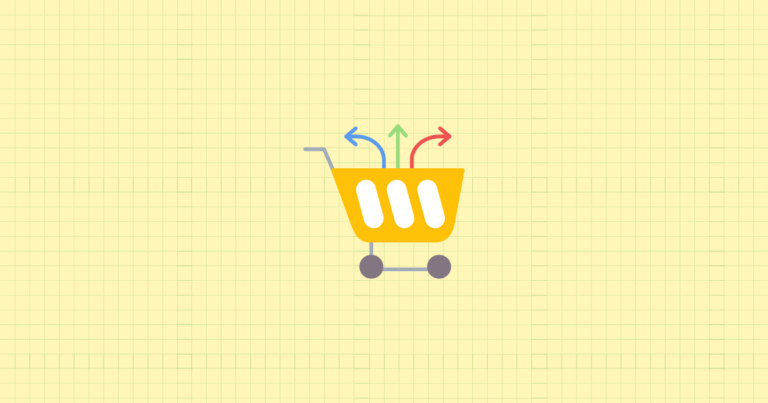
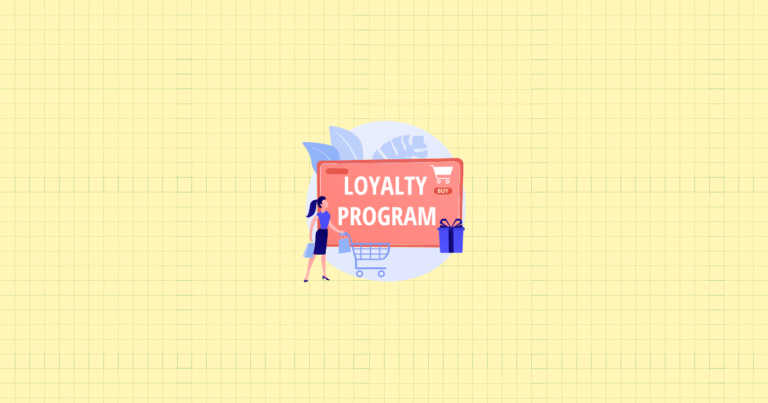
[…] The Complete Guide to Shopify Discount Types and When to Use Them […]
[…] The Complete Guide to Shopify Discount Types and When to Use Them […]